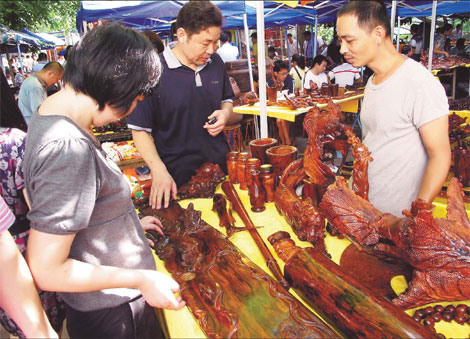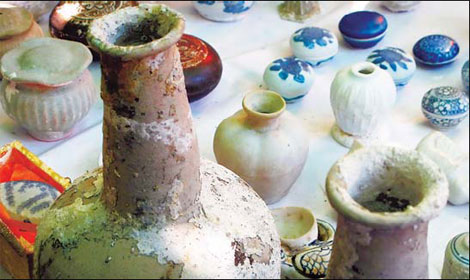Life and Leisure
King of woods
By Huang Yiming and Li Xing (China Daily)
Updated: 2010-09-08 07:31
 |
Large Medium Small |
|
Most visitors to Haikou's Flower and Bird Street come in search of handicrafts and furniture made from huanghuali wood. Photos by Huang Yiming / China Daily |
Neither Hainan's sunken ceramic treasures nor the creative expressions of its ethnic Li folk are any match for the huanghuali, a rare species of rosewood that once adorned imperial abodes, Huang Yiming and Li Xing report
For many antique chasers scouring Panjiayuan market in Beijing, their next stop could be as far away as Haikou, capital of the southern island province of Hainan.
Its Flower and Bird Street, which starts by Haikou People's Park in the south and ends on Guangchang Heng Lu in the north, is the place to savor the three treasures of Hainan - huanghuali (a kind of rosewood), antique ceramics and silk embroidery of the ethnic Li people.
The ceramic pieces, pulled up from ships lying at the bottom of the sea, reportedly date back to the Qing (1644-1911), Ming (1368-1644) or even earlier dynasties.
The ships are believed to be merchant vessels that plied the "sea Silk Road" between China and possibly the Middle East and Europe.
Good finds are rare but well worth the search. Xing Xiuli, who runs one of the ceramic shops, says she recently came across a cup called the "general's cup". It is believed to date back to the early Song Dynasty (AD 960-1279).
A well-preserved cup can sell for as much as 10,000 yuan ($1,474), but Xing is willing to let it go for 8,000 yuan, considering it has lost its glaze.
Many of the items that Yang Wenliang of the Li ethnic minority sells are handicrafts made by this group.
"In the past, Li people did not sell family 'valuables'," Yang says. "However, times have changed."
But most visitors to the street of flowers and birds come in search of handicrafts and furniture made of huanghuali, or "yellow flowering pear" wood.
Its color varies from reddish-brown to golden-yellow, and the grains on its often shiny surface are a treat for the eyes.
Huali, as the locals call it, is highly valued, being one of the few hard woods used to make royal furniture.
Wang Shixiang (1914-2009), an expert in classical Chinese furniture, describes huanghuali as having the "perfect" color, "neither too subdued nor too showy". Of the 160 pieces of fine classical furniture featured in Wang's book Ming-style Furniture, more than 100 are made of huanghuali.
However, there is a limited supply of huali wood in Hainan. The wood itself comes from the core of the huali trees, and the core begins to develop only 15 years after the saplings are planted. The girth of a 20-year-old tree stands between 17 and 20 cm, but the core measures just 2 to 5 cm in circumference.
It takes a huali tree 100 years to mature, but in nine out of 10 older trees, the core becomes hollow. Ancient annals record that local Hainan chieftains used to send huali wood as contributions to the royal family once every three years.
The volume of new huali wood originating in Hainan is so small the wood has now been placed under State protection. Its sale is banned, says Ou Zongwen, chairman of the Hainan's antique collectors' association.
At one time, even the water buffaloes in some Hainan villages wore huali bells, but such bells are not seen now.
According to Wang Liangsen, a local art and crafts master, the wood sold at 2 yuan per kilogram back in the early 1970s. But today, it goes for close to 2,000 yuan ($295) a kilogram.
Liu Xiaoli contributed to the article.
|
Ceramic pieces from sunken boats are another feature of the market. |

